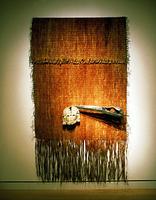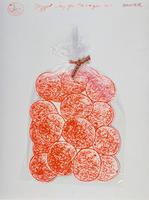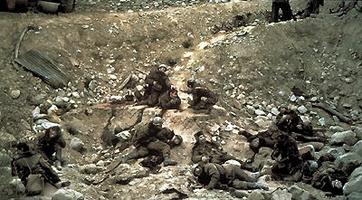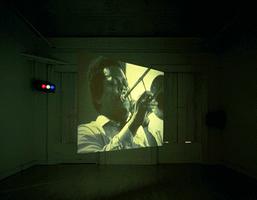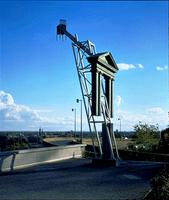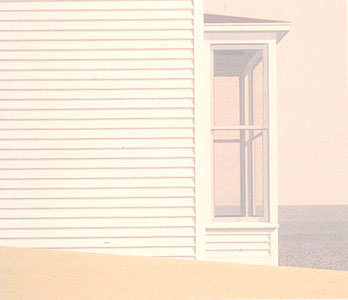Art, Contemporary Trends
Contemporary art in Canada, as elsewhere, is marked by a questioning of the nature of art - what art has been about historically, what it ought to be about, and who its intended audience is to be. This questioning has been accompanied by experimentation and innovation. The resulting work varies in content from the intensely personal to the public investigation of social and political issues; it ranges in form from the intellectually disciplined to the free and intuitive; and differs in production from the solitary to the collective.
As traditional art forms were discarded, contemporary art tested its limits as seldom before: it explored the link between means and ends, reset the boundaries between art and "reality," and redefined the art object in its aesthetic, social and economic contexts. The art processes gained momentum and direction from forces as varied and contradictory as developments in computer and communications technology; Oriental mysticism; new thinking in the social and behavioural sciences and in philosophy and linguistics, including the work of Marshall MCLUHAN; and from the international flow of ideas about art, coming during this period largely from the US - but, as modernism gave way to post-modernism, increasingly coming again from Europe. The need to experiment was met by the new materials and tools made available by technological advance - plastics; lasers; new photographic techniques, including holography; computer technologies, including virtual reality; and the communications media - which by their nature suggested alternative contexts for art and access to a wider audience.
Both Fusion des Arts in Montréal (founded 1964) and Intermedia in Vancouver (founded 1967) grew out of this climate. They were loose groupings of artists working in different media (film, music, dance, poetry) and in the traditional categories of painting and sculpture, which were perceived by many to be pointlessly restricting when isolated. Glenn Lewis, Glenn Toppings, Dennis Vance, Dallas Sellman, Gary Lee Nova, Evelyn Roth, Gerry Gilbert and many others were associated with Intermedia, although they often worked co-operatively or anonymously through pseudonyms. The artists of Fusion, whose founders were Richard Lacroix, François Soucy, François Rousseau and Yves Robillard, also pooled resources and shared ideas. The resulting happenings and performances - works combining touch and sound, vision and movement to experiment with sensory awareness, located as often outside as in an art gallery - exuded a sense of optimism about the anticipated social benefits to be gained from the arts now that they were speaking a common and comprehensible language.
In forming the N.E. Thing Company (1966, incorporated 1969), Iain and Ingrid (formerly Elaine) Baxter, who were among the founding members of Intermedia, demonstrated multimedia and interdisciplinary principles by setting up categories of their own, departments of their company that would deal with its multifarious products. These included vacuum-formed still lifes, inflatable plastic landscapes, works transmitted by telex, photographs of found images bearing the N.E. Thing Co's ACT (Aesthetically Claimed Thing) or ART (Aesthetically Rejected Thing) seals - and all of it to stimulate the GNG (Gross National Good), which was far more important than the GNP (Gross National Product). A company button proclaimed the message "Art is all over" - meaning that art can literally be anything at all, or else nothing special. It was a logical extension of the gesture, newly influential in the 1960s, made in 1913 by French artist Marcel Duchamp when he mounted a bicycle wheel on a stool and displayed it in an art gallery along with other "Readymades." In demonstrating that art could be a business with a product (Visual Sensitivity Information) the N.E. Thing Company was trying to demystify art, to link it to the real world, and to show, as Duchamp had done, that art is in the eye of the beholder.
Despite its mimicry of capitalist business practices, the N.E. Thing Company shared the conviction of many progressive artists of the time that art should not be understood primarily as a marketable commodity. Among numerous suggestions Les Levine has made since the late 1960s about how else art might be understood were his "Disposibles" (1968-69). These brightly coloured, vacuum-formed plastic modules were intended to be disposable, had no inherent value as objects, and could be arranged and rearranged at the whim of their owners. Levine's idea was the art; how it looked was up to anyone else.
Michael SNOW, like Levine, was living in New York at this time. In their different ways they were responsible for channelling the ideas of conceptual art into Canada, though by its nature it easily travelled through the mail, magazines and word of mouth.
Conceptual Art
Conceptual art maintained that if the traditional forms of painting and sculpture were bankrupt and abstraction merely an irrelevant attenuation, then the object in making art was to isolate some essential "artness" that existed independently of any form it might take. The main result of conceptual art in Canada has been a way of thinking about art rather than any notable works, though the most memorable ideas were those that were given some kind of form and, therefore, were not properly conceptual. Snow has centred his work on an internally consistent exploration of the camera's potential, a process that has resulted in films and works both on and off the wall, of great poetry and coherence. Snow's work, which has an international following, has been an inspiration for many other artists, especially those for whom art stands or falls on the basis of the strength of its idea or concept.
In the early 1970s the NOVA SCOTIA COLLEGE OF ART AND DESIGN in Halifax was the focus for conceptual art in Canada. Characteristic of work by influential staff at NSCAD was Eric Cameron's "Camera Inserted in My Mouth" (1973-76), in which the camera lens was inserted into the artist's mouth for the duration of a standard 30-minute tape, with the only visible record on an otherwise black monitor being the shadowy trickle of saliva. This work used the medium to clarify an idea about the ultimately self-reflexive nature of art.
In "One Million Pennies" (1980) Gerald FERGUSON gave vivid realization to the critical notion that art and money might be synonymous - no other way having been devised to indicate value - in a work that consisted of a heap of one million pennies, newly minted, on a gallery floor. The paintings of Garry Neill Kennedy are also typical of a later development of conceptual art. Intending a comment on the irreducible nature of paintings as art objects, Kennedy perversely located it in format and pigment. He systematically analyzed the colours and sizes of 32 paintings from the permanent collection of the Art Gallery of Ontario. The result was a parallel and entirely schematic series of drawings, Canadian Contemporary Collection - The Average Size - The Average Colour (1978), the 33rd item representing the average of the total.
Body Art
While conceptual art remained concentrated in eastern Canada, body art, in which the artist's person is interpreted as both the source of all ideas about art and the ultimate tool in their realization, was the related form that gained the widest following. In Vancouver it became part of the aesthetic of anarchic satire and expressive indulgence that characterized the work of Al Neil and the artists of the Western Front; in Toronto it served to release the interest of many artists in the exploration and expression of the individual. Everywhere it was used to further the feminist cause. Montréal artist Sorel Cohen gave graphic summation to the physical activities (bed making, window cleaning) and social role (organizer and homemaker) traditionally expected of women. In accord with the pared-down sensibilities of minimal and conceptual art, Cohen's photographic sequences reproduced the physical experience directly, without poetry or drama.
In "Smile," a prototypical videotape of the period made by Albert McNamara in 1971 while a student at NSCAD, the particularity of an individual's smile is lost in a half-hour-long contemplation of a generalized cliché about the body and its expressiveness. Video, with its unique blend of privacy in the making and infinite publicity for the product, adapted well to the concerns of body art. In "Birthday Suit," Lisa Steele scrutinized the scars and defects of her body while recounting their history. Vincent Trasov, whose work for 5 years consisted of disguising his body as a peanut, ran, as Mr Peanut, for mayor of Vancouver in 1974; his campaign - an artist/politician encased in his image in the public arena - put in a nutshell the predicament of art and the artist in taking meaningful roles in society.
That response to the body (its definitions and boundaries are volatile and intimately associated with socio-political attitudes) became evident from the public response to Jana Sterbak's "Vanitas - Flesh Dress for an Albino Anorectic" (1987) when it was exhibited at the National Gallery in 1991. The simple garment made from slabs of raw beef succeeded in integrating ideas about female flesh and animal flesh, spectacle and consumption, food and sex, in ways that would seem to substantiate the notion that its reception plays an important part in the creation of a work of art.
Genevieve Cadieux, whose work deals with the difficulties of deciphering the body, positioned a woman's red lips, barely parted, as an immense illuminated sign on top of a building in Montréal. "La voie lactée" (1992) showed that it is far from clear how even the clearest emblems of the body, enhanced by the clarity of advertising technology, should be "read." These artists and many others have contributed importantly to the investigation of the connection between the body and the body politic, between acts of seeing and acts of knowing, and the forces that shape access to knowledge.
Environmental Art
Awareness of the person is extended in environmental art into the person's awareness of the environment. Reality "out there" is thought to have more presence, more potency, than any representation in paint or other traditional medium. The artist intervenes only to appropriate the existing qualities. Since the late 1960s this very durable strategy has been employed to very different ends. For a number of years, Irene WHITTOME has been installing in galleries objects and colours that she has made to be metaphors for her feelings about a particular place, room or city, so that the original atmosphere is recreated.
In 1971 Bill Vazan's "World Line," which was realized with the help of a civil engineer and many people in 25 different locations around the world, cast an imaginary, zigzag line around the globe. Its only visible form was 25 angles in black tape on 25 floors, the arms of each leading geodetically on to the next point on the line. "World Line" invited us to consider (as did another work of Vazan's that put Canada in parentheses, with brackets drawn on beaches in PEI and Vancouver I) some of our strongest preconceptions about an environment that we are hardly able to conceive.
In "Defunct" (1981), Rita McKeough installed in the gallery of the Alberta College of Art replicas that she had built of old houses of Calgary. In the evenings she came into the gallery to destroy them, acting out her strong feelings about the wanton destruction of our urban environment. In "Destruck" (1983) the houses have evolved arms with which to defend themselves, but the ensuing fight with the bulldozers only prolongs the death throes.
The architectural environment also concerns Melvin CHARNEY, Montréal architect/artist who, in the street gallery, recreates versions of the vernacular architecture that he feels we overlook and destroy at our peril; when we lose the past that is written on our buildings, however humble, we risk losing our identity in the present. In 1976 Charney orchestrated "Corridart," in which Sherbrooke St, Montréal's main processional axis, was transformed by responses to the street and its history from many of the city's artists. In a vivid demonstration of the power of art, Mayor Drapeau, within a week of its installation and before the Olympic visitors arrived, ordered the destruction of what was perceived as a threat.
Krzystof Wodiczko's "Public Projections" reveal that we see a building or locale as a myth in an interplay with changing social and cultural circumstances. Using slide projectors, he temporarily projects images of this myth on the physical structures themselves. The images projected onto the facade of the Art Gallery of Ontario in 1981 suggested the collusion of art, business and cultural bureaucracy. The myth we construct around mountains, and the very different ones associated with nuclear weapons, together with the announcement of the planned testing of the US Cruise missile in Alberta, led to its projection of the image of that missile on a rock face near Banff.
Correspondence Art
Correspondence art uses the postal system for its distribution and provides another method of circumventing the confines of art object and art gallery. Chuck Stake (Don Mabie), who has been mailing out of Calgary for 2 decades, and Anna Banana are 2 of Canada's most prolific links in a global network of those who make and share art for the price of postage. The advent of the Internet has increased the possibilities for networking, self-expression and self-promotion exponentially. It is a function of the technology that artists' Web sites, like any other, can be either highly personal and directed towards a specific audience or global in scope and ambition.
Collage
Collage is the random assemblage of found images in such a way that the whole has impact and meaning that is greater than the sum of its parts and has complex roots in Duchamp, dada and the early surrealists. It fits a contemporary notion that we have no grounds for discriminating between one object or image and another, or between one interpretation and another, since all have a part to play in the way we construct our view of the world.
This idea is also a component of structuralism, an approach to knowledge made widely accessible through the writings of the French anthropologist Claude Levi-Strauss. His remark, "The decision that everything must be taken into account facilitates the creation of an image bank," provoked Michael Morris and Vincent Trasov to initiate Image Bank in Vancouver - a flow of images and requests for images that circulated around an international network of visual artists, poets, writers and musicians, thereby extending the chance of random relationships and juxtapositions in a scheme of things where everything was worth something. These same ideas inspired Glenn Lewis to initiate the "Great Wall of 1984" (1973). He invited 165 people to contribute the contents of 365 plexiglass boxes, which were stacked along the wall, forming a huge co-operative collage that intrigued passersby at the National Science Library in Ottawa.
The re-emergence of collage has been followed by the return of imagery. Illusion, drama, narrative, often used reflexively, accompany an intense scrutiny of modes of representation. In the pluralist situation prevailing by the late 1970s, one response has been analysis. An intellectual and highly self-aware analysis of how contemporary art can proceed and claim meaning and status for itself, echoing similar procedures elsewhere, is offered in the work of 2 Vancouver artists, Jeff Wall and Ian Wallace. They use photography to scrutinize the value of images, their own and those of the mass media, and to ask how the "art" version of them is distinguishable from any other version.
Wall's epic "Dead Troops Talk (a vision after an ambush of a Red Army patrol, near Mogo, Afghanistan, Winter 1986)," like most of his works a back-lit Cibachrome transparency, is no less disturbing for using art historical and filmic conventions to distance the deadly mise en scène from documentary reportage, a mode through which the mass media have conditioned our responses. Pursuing similar investigations, but in a medium once thought to be dead, are painters such as Bob Boyer, Claude BREEZE, Eleanor Bond, Yvon Gallant, Betty Goodwin, Robert Houle, Wanda Koop, Atilla Richard Lukacs and Joanne Tod.
Their knowing and reflexive borrowing from art historical modes, often combined with those of advertising or sign painting or communications technologies, forms part of an ongoing debate about whether art is always, and everywhere, an autonomous project subject to rules of its own, or whether it is part of a wider language of signs implicated in, and dependent upon, the immense array of cultural representations of all kinds. Ken Lum and Robert Fones are 2 very different artists whose work scrutinizes the appearance of language as sign.
Performance Art
Performance art, often with related installations, has been one of the most significant of the hybrid art forms, variously betraying its origins in the political urgency of agitprop, the high spirits of dada cabaret, the spontaneity of the happening and, in a concern with the processes through which images and ideas acquire meaning or have their meaning eroded, in its relationship with conceptual art. Bruce Barber, in carefully didactic performances, offers a reproof to both senders and receivers of the implicit sociopolitical content offered in the mass media. Elizabeth Chitty shows how we can meet the essentially sensory blandishments of those same media, while Marcella Bienvenue in her performances re-enacts the philosophical confusion into which the individual must inevitably be thrown by the media barrage. In these instances, and many others, performance has been an effective vehicle, though by no means the only one, for the concerns of feminism.
An outrageous parody of this society and its promotional styles has been evolved through an ongoing series of performances, videotapes, installations and more by General Idea, the alias of 3 Toronto artists, A.A. Bronson, Felix Partz and Jorge Zontal: all art needs some kind of promotion and must make or find for itself a context if it is not to be socially meaningless.
Installation Art
Installation art is not always easily or accurately distinguished from performance art, from site-specific work or from sculpture. Faye Heavyshield, John McEwen and Rodney Graham might be cited as very different artists whose work offers a spatial encounter but is also critically directed at a cultural construct or specific historical moment. In the case of Liz Magor's "Child's Sweater c 1970" (1989) and "Field Work" (1989) the moment recalled is the late 1960s on the West Coast when she and her friends constructed their own "culture" based on such knowledge as was available to them about Native culture. These pieces, evocative, reflexive and knowing as they are, have been criticized as being culturally appropriative and defended as clarifying the processes through which art history has moved, in a climate where rights to ownership of culture have been widely debated. Nell Tenhaaf's work addresses some of the cultural implications of the new technologies, for example "Species Life" (1989) and "Horror Autoxicus" (1990).
Sara Diamond's "Patternity" (1991) transforms a gallery into what she calls "the theoretical living room," an intellectually defined space in which to debate the construction of family identity. Its upholstery and curtains, its TV screens, its very air is patterned with the sounds, maps and images of her father's life and how it has patterned her own. Feminist analyses of the meshing of the personal with the political, the influence of psychoanalysis on the family, and theorizing the densities of personal experience are brought together in this piece.
Edward POITRAS in his mixed-media installations such as "Stars in Sand" (1982) and "Big Iron Sky" (1984) conveys the disturbing and wry poetry that results from the ambivalence of FIRST NATIONS artists towards their ancestry and the art forms of their ancestors. Many First Nations artists from all parts of the country are searching for forms that combine elements from traditional arts and mythology with their own, frequently angry, responses to the present. Among them are a growing number of women, for example Joane Cardinal-Schubert, Theresa Marshall and Debra Sparrow, who insist on imagery, techniques and issues that are specific to women of Aboriginal descent.
Carl Beam is in the forefront of those who argue that their ethnicity- in Beam's case Ojibwa- is secondary to their role in the larger society, even, or perhaps especially, when it provides the content. This places him in the company of the many artists who take the risk of creating a personal mythology, as opposed to relying on one sanctioned by virtue of membership in a social group. Gathie FALK'S"tableaux vivants," similar to her work in other media, show that it is possible to communicate effectively through a set of highly idiosyncratic symbols.
Within the past 25 years, political art has moved from connoting "protest" to a position from which it can investigate the myriad forms taken by the exercise of power in human affairs: of states over subjects, of colonizers over colonized, of institutions over individuals, of men over women - or vice versa. For example, Mark Lewis, as part of a wide-ranging scrutiny, which included a film made with Laura Mulvey, "Disgraced Monuments" (1993), on the fate of statues of Lenin since the collapse of the Soviet Union, sited replicas of the fallen monuments in various public spaces in Canadian cities. The responses attested to the different and complex ways in which public monuments articulate power in democratic and totalitarian regimes.
In his large and vivid paintings such as "Red Man Watching White Man Trying to Fix Hole in Sky" (1990) and "Scorched Earth, Clear Cut Logging on Native Sovereign Lands, Shaman Coming to Fix" (1991), Lawrence Paul Yuxweluptun draws on his own Cowichan spirituality to attack the "toxicological intrusions on native land" which daily threaten his people with a moral and physical pollution. Greg CURNOE's untimely death in 1993 cut short a lifelong project of identifying himself through the terms established by the resources - historical, geographical, architectural - of his home community of London, Ontario. With the aid of computers, he had begun to chronicle the precise history of use and ownership, to earliest times, of the acre of land he owned, a history that was a microcosm of dispossession and litigation imposed by settlers on the Aboriginal population. A small publication, Deeds Abstracts (1992), had begun to give an indication of the richness of this resource.
The personal poetry found in recent performance works by Bruce Parsons is used to point up a message of the widest relevance: the imbalance between humanity's use and abuse of the natural world in advanced industrial societies. Among the growing number of artists who are prepared to appropriate any means, including the so-called "revival" of painting, to make uncompromising response to a troubled world, 2 should be mentioned: Jamelie Hassan who, in "Desaparecidos" (1981), recreated in all its desperate anguish the protest of the grandmothers of the "disappeared ones" of Argentina, and Ron Benner, whose works deal with the plunder of nature by humanity, of one society by another.
How artists can operate at all in the compromised role allowed by their historically privileged position is the question that Carol Condé and Karl Beveridge have attempted to answer in photographic installations, which deal with specific social issues such as the personal consequences of strike action and the role of women in the workplace. For Brian Dyson, who founded Syntax (Calgary International Artists' Contact Centre) in 1980, and his colleague Paul Woodrow, the only solution to the predicament of art, the only way to meet their social responsibilities, has been to stop making art and devote their energies to animating broadly based cultural activities in their local Calgary community of Hillhurst-Sunnyside. They believe that today direct social action is the only effective way for artists to give form to their ideas and perceptions.
Other artists, particularly in Toronto, among them Janice Gurney, Carol Laing and Ian Carr-Harris, chose to deal with this predicament by insisting that a valid art practice can only be founded on theory - the articulation of ideas and prescriptions gathered by various intellectual disciplines, which are reflected in, or implied in, the work.
There is a widespread sense, not confined to Canada, that art and the discourse by which it is legitimated exist in a symbiotic relationship. At present that discourse is characterized by sometimes bitter disputes centred on ethnicity and gender and how these factors do, or should, make a difference in the production and reception of art.
Rebecca Belmore is notable among First Nations artists in having made pieces that are dependent on finding a voice for the marginalized and disenfranchised voices of her own Ojibwa community, people for whom the art of art galleries does not have much significance. "Ayum-ee-aawach Oomama-mowan: Speaking to their Mother" (1991) is an enormous megaphone, specially made, through which, in a number of locations across the country including Parliament Hill (which is part of an Algonquin land claim), she invited First Nations people to address their Mother Earth directly. "Mawu-che-hitoowin: A Gathering of People for any Purpose" (1992) was a circle of well-worn chairs. Visitors who sat in them could listen, through attached headphones, to the stories of their owners told in their own voices.
Whether art is legitimated by its politics, and what they could be, or by its quality, and what that is, is fiercely debated once again. In a sense these are the issues of the 1960s, but differently inflected in the mid-1990s. They have become more consequential in a society that has lived through the Oka crisis, land claims, increasing awareness that Canada has grown as both colonized and colonizer, demands for equal rights for women, the AIDS epidemic, and the consequent politicization of health issues, and the consequences of cultural distinctiveness amongst immigrants.
In Canada the diversity of contemporary trends in visual art has been compounded by the distance between centres of art activity with their different histories, resources and response to outside influences. This isolation has been offset by official support for programs enabling exhibitions or individuals to travel across the country, for a network of galleries and alternative spaces, and for a number of art publications with national distribution: Canadian Art, Border Crossings, Collapse, Fuse, C Magazine, Matriart, Mix, Parachute, Vie des Arts , Provincial Essays and Public Access. Many communities across the country also produce their own magazines or newspapers. Cheap or free, sometimes short-lived, they come out of, and help to focus, local energies and issues.
In a period that has seen great population growth in the metropolitan centres and great demographic change across the country, as well as steady erosion of government funding, Canada is coming to be characterized as much by regional differences and differential access to alternative means of support, as by national and international connections.
Corporate and private sources of funding are having an effect, while in the arts community alternatives are again being sought, often in different kinds of collective activities and various kinds of social activism where the boundaries between art and social issues are once again blurred. Whether or not work in these regions is made in response to the local social and political economy, art in Newfoundland, in Acadia, in the rest of Atlantic Canada, in Québec, several distinct regions of Ontario as well as Toronto, the prairies, Alberta and BC, is too distinct to be generalized.
At the turn of the century it has become hazardous to discern and generalize specific trends. In a sense it is impossible to do so, given the exponential increase in ways of making work known, of formatting and distributing it, of authenticating and analysing it. The use of photography and photo-based imagery is so prevalent as to make a special category of photography-as-art redundant, while painting, both abstract and figurative, is taken up anew or with a kind of knowing historical amnesia. The global reach of technologies now readily available has further complicated prevailing interrogation of the histories of art and the role of the artist as originator. At the same time the expressive needs and capacities of cultural communities, newly arrived or well established in Canada and perceiving themselves as distinct, are so diverse that, once again, doubt is cast as to whether an identifiable Canadian art is either possible or interesting.

 Share on Facebook
Share on Facebook Share on X
Share on X Share by Email
Share by Email Share on Google Classroom
Share on Google Classroom


